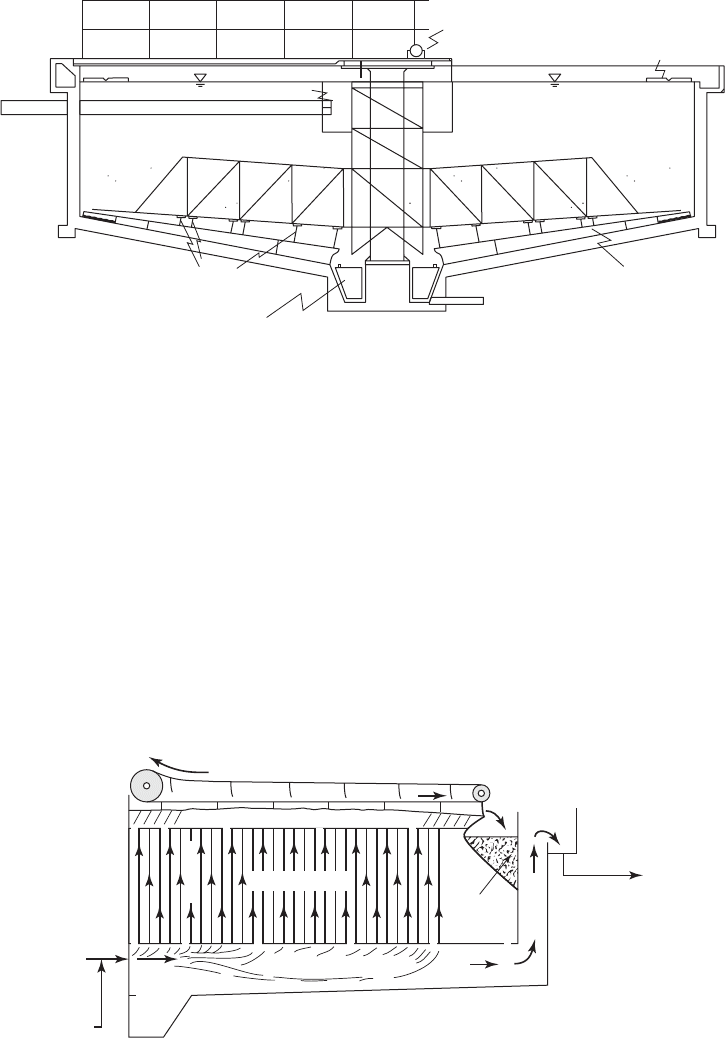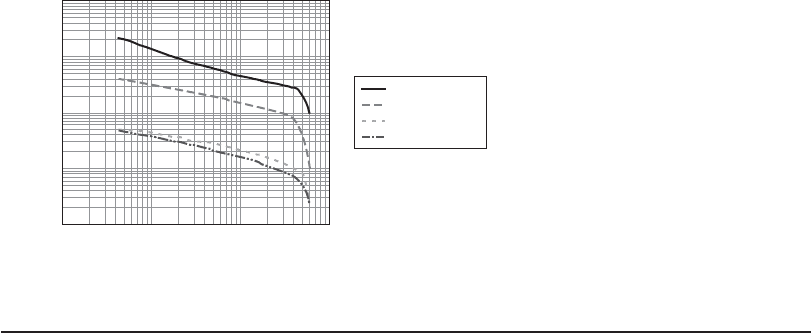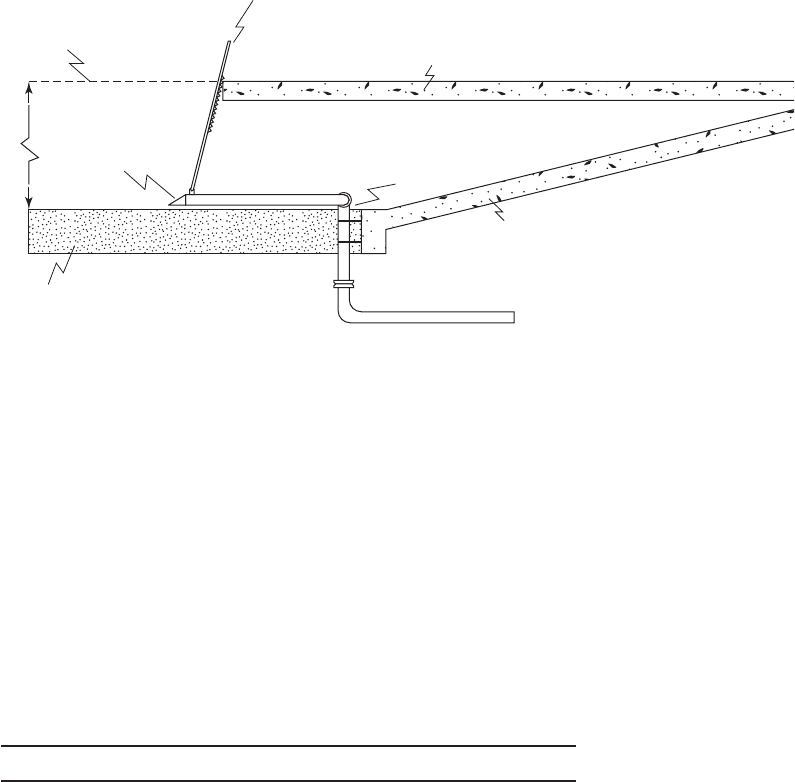Water and Wastewater Engineering
Подождите немного. Документ загружается.


WATER PLANT RESIDUALS MANAGEMENT 15-17
Thickening may be accomplished by gravity settling or flotation. Gravity thickening is usu-
ally accomplished by using circular settling basins similar to a clarifier ( Figure 15-2 ). Dissolved
air flotation (DAF) thickeners typically are rectangular as shown in Figure 15-3
. Thickeners can
be designed based on pilot evaluations or using data obtained from similar plants.
The addition of polymer significantly improves the performance of thickeners (Peck and
Russell, 2005).
Gravity Thickening. As noted in Chapter 10, when the water contains a high concentration of
particles (for example, greater than 1,000 mg/L), both Type III ( hi
ndered settling or zone settling )
and Type IV ( compression settling ) occur along with disc rete and flocculant settling. Zone set-
tling and compression settling occurs in sludge thickeners.
A s with Type II settling, the methods for analyzing hindered settling require settling test
data. These methods are appropriate for plant expansions or modifi
cations, but have not found
Influent
pipe
Feed well
Drive
Weir
Stilts
Center
scraper
Sludge withdrawal pipe
Plows
FIGURE 15-2
Continuous-flow gravity thickener.
Thickened sludge collector
Thickened sludge blanket
Separation zone
Water
sludge
Air flow
Thickening zone
Air-charged steam
(screened primary
effluent or final effluent)
Sludge
hopper
Subnatant
FIGURE 15-3
Dissolved air flotation (DAF) thickener.

15-18 WATER AND WASTEWATER ENGINEERING
use in the design of treatment plants where process sludges from treating the actual raw water are
not available. However, they are useful in explaining the behavior of thickeners and demonstrat-
ing the controlling design variables.
Dick has described a graphical procedure for sizing gravity thickeners u sing a batch flux
curve * (Yoshioka et al., 1957; Dick, 1970). Flux i
s the term used to describe the rate of settling of
solids. It is defined as the mass of solids that pass through a horizontal unit area per unit of time
(kg/m
2
· d). This may be expressed mathematically as follows:
FCv
C
su
s
()()
()( )zone settling velocity
(15-23)
where F
s
solids flux, kg/m
2
· d
C
u
concentration of solids in underflow, that is, the sludge withdrawal pipe, kg/m
3
C
s
suspended solids concentration, kg/m
3
v underflow velocity, m/d
The sizing procedure begins with a batch settling curve such as that shown in Figure 15-4.
The data for the settling curve are obtained by filling a transparent cylinder with sludge that is
well mixed to distribute the solids. At time zero, the mixing intensity is re
duced and the solids are
allowed to settle. Type III settling produces a distinct interface so the measurement of the height of
the interface at various time intervals allows the calculation of a settling velocity. This experiment
is conducted at several different sludge concentrations that are obtained by dil
uting the sludge.
Vesilind (1979) has outlined some of the critical factors in in conducting the test. These
include:
• A cylinder diameter as large as possible, but not less than 20 cm in diameter,
• An initial height that is, preferably, the same as the thickener, but not less than 1 m,
• Filling the cylinder from the botto
m, and
• Stirring the cylinder very slowly at a speed of 0.5 rpm during the test.
* The original development of this method was by N. Yoshioka and others.
0.1
1
10
100
1000
0.1 1 10 100
Subsidence rate, m/d
Suspended solids concentration, kg/m
3
Lime
Filter backwash
Alum
Iron
FIGURE 15-4
Batch settling curves.

WATER PLANT RESIDUALS MANAGEMENT 15-19
Data from the batch settling curve are used to construct a batch flux curve ( Figure 15-5 ). Know-
ing the desired underflow concentration, a line through the desired concentration and tangent to the
batch flux curve is constructed. The extension of this line to the ordinate axis yields the des
ign
flux. From this flux and the inflow solids concentration, the surface area may be determined.
Example 15-3 illustrates the procedure and the application of the controlling design variables.
Example 15-3. A gravity thickener is to be designed to thicken a lime softening sludge from
a conventional settling bas
in. The sludge flow rate is 171.2 m
3
/ d, and the solids mass loading is
4.28 10
3
kg/d. The limiting overflow rate to prevent carryover of solids is 0.4 m/h. The thick-
ened sludge should have an underflow solids concentration of 20.0%. Assume that the sludge
yields a batch settling curve such as that shown in Figure 15-4. Determine the required surface
area and diameter of the thickener for thickening, and
verify that the hydraulic loading rate is
acceptable.
Solution:
a . Begin by calculating solids flux ( F
s
) and plotting the solids flux curve. The explanation
of the computations is given below the table.
SS, kg/m3
v, m/d F
s
, kg/d m2
210 0.43 90.3
150 0.86 129
100 1.7 170
80 2.6 208
60 5.1 306
507.5375
40 14 560
30 35 1,050
25 45 1,125
1555 825
10 60 600
0
200
400
600
800
1,000
1,200
0 50 100 150 200 250
Suspended solids concentration, kg/m
3
Solids flux, kg/d·m
2
FIGURE 15-5
Batch flux curve.

15-20 WATER AND WASTEWATER ENGINEERING
The suspended solids c oncentrations (SS) in the first column were selected arbitrarily.
The data in the second column were read from Figure 15-4 at the abscissa points noted
in the first column. The data in the third column are the products of the first and second
c
olumn; that is, 210.0 0.43 90.3, 150.0 0.86 129, and so on.
Converting the first column to percent and plotting the SS in kg/m
3
versus the last
column yields the batch flux curve ( Figure 15-5 ).
b. As shown in the figure, the tangent line from the desired underflow solids concentra-
tion of 20% yields a solids flux of 320 kg/d · m
2
. (The percent solids concentration is
0.10 times the SS in kg/m
3
.) With safety factor of 0.667, the design solids flux is
F
s design
kg/dm kg/()()320 0 667 213 44
2
..ddm
2
c. The solids mass loading is given as 4.28 10
3
kg/d. Therefore, the required surface area
of for thickening is
A
s
428 10
213 44
20 05 2
3
2
.
.
.
kg/d
kg/dm
or 00
2
m
d. The diameter of the thickener is then
D
12
2
420
505 5
/
m
or m
()( )
⎛
⎝
⎜
⎞
⎠
⎟
.
e. Check the hydraulic loading criterion by calculating the overflow rate with this surface
area.
v
0
3
2
171 2
20
8 56036
.
..
m /d
m
m/d or m/h
This overflow rate is acceptable because it is below the design criterion of 0.4 m/h.
Comments:
1 . If the hydraulic loading criterion is exceeded, then the surface area of the thickener is
governed by the hydraulic loading criterion, and the surface area and diameter are recal-
culated using the overflow rate criterion.
2. This is
a small thickener. It may not be economical to build a thickener this small because
the savings in disposal cost may not be recovered by the end of the design life of the
thickener.
Gravity Thickening Practice. Typical gravity thickener d esign parameters are summarized
in Table 15-5 . Wasting to the thickener may
or may not be continuous, depending upon the size
of the WTP. Frequently, smaller plants will waste intermittently because of work schedules and
lower volumes of sludge. Typically, the supernatant suspended solids levels are quite high. Thus,

WATER PLANT RESIDUALS MANAGEMENT 15-21
the supernatant must be returned to the head end of the WTP. This is a particular problem for
surface water plants because it results in an increase in the concentration of Cryptosporidium and
Giardia.
The primary design elements are the diameter, depth, and required drive torque. In the
absence of an operating facility
that is generating sludge for laboratory development of design
data, typical values for the solids loading and design overflow rate (initial settling velocity) are
used to estimate the tank diameter. The calculation is the same as that shown in Example 15-3
starting at step (c).
The depth of the tank is typically divid
ed into three parts for conceptual design: (1) the free-
board above the sludge liquid surface, (2) a settling zone where the particulate matter separates
TABLE 15-5
Range of typical gravity thickener deign parameters
Parameter Typical range Remarks
Alum Iron Lime Filter backwash
Specific gravity
of solids
1.2–1.5 1.2–1.8 1.9–2.4 1.0–1.025 For both granular and
microfiltration filter
backwash
Specific gravity
of sludge
1.025–1.1 1.05–1.2 1.01–1.2
N/A
a
Percent solids
from settling
tank
0.1–2%
2–4%
0.1–2%
2–4%
2 and 15% 30–400 mg/L Nominal value for
lime 10%
Highly turbid water
Sludge volume 0.1–3% 0.1–3%0.3–5% 3–10% % of water treated
Initial settling
velocity
2.2–5.5 m/h 1–5 m/h 0.4–3.6 m/h 0.12 m/h
0.2–0.7 m/h
No coagulant for
filter backwash
With coag
ulant for
filter backwash
Solids loading 15–80 kg/d · m
2
15–80 kg/d · m
2
100–300 kg/d · m
2
N/A
Percent solids
from thickener
3–4% 3–4% 15–30% 70–90% Recovery of applied
solids in mg/L
Safety factor for
solids flux
0.667 0.667 0.667 0.667 When based on lab
data
Thickener
diameter
b
3–50 m3–50 m3–50 m N/A In 0.3 m increments
for small tanks
In 1.5 m increments
for large tanks
Thickener SWD 3–6 m3–6 m 4–6 m N/A For tanks 3 to 50 m in
diameter
a
N/A not available.
b
Although diameters up to 180 m are advertised in manufacturers’ literature, they are rarely used for water treatment plant sludges. Sources: Cornwell,
1999; Kawamura, 2000; MWH, 2005; Peck and Russell, 2005.

15-22 WATER AND WASTEWATER ENGINEERING
from the liquid, and (3) the thickening zone at the bottom of the tank. Typical values for the free-
board and settling zone are 0.6 and 2 m respectively. The thickening zone is calculated as (U.S.
EPA, 1979):
H
Mt
PA
s
ss
thickening
average
()()
()()()
(15-24)
where H
thickening
height of thickening zone, m
M
s
mass of solids applied, kg
t storage period for thickened sludge, d
P
s average
average solids fraction in zone
density of water, kg/m
3
A
s
surface area of thickener, m
2
For continuous underflow thickeners, one to two day’s storage is typically provided. The aver-
age solids fraction ( P
s average
) is estimated as the average of the influent solids fraction and the
underflow solids fraction.
The required running torque drive may be estimated as (Boyle, 1978):
TWrg ()()()
2
(15-25)
where T running torque, J
W truss arm load, kg
f
/ m
r radius of scraper arm, m
g gravitational acceleration, 9.81 m/s
2
E xample values for the truss arm load for water treatment sludges are 15 kg
f
/ m for coagulant
sludge and 22 kg
f
/ m for lime sludge (WEF, 1998). Manufacturers should be consulted for design
estimates. In addition to the running torque, the alarm torque (120 percent of running torque),
shut-off torque (140 percent of running torque), and peak torque (the torque that will cause im-
minent failure, 200 percent of running torque) must be spe
cified. Manufacturers have advertised
running torque capability of greater than 1 MJ for 45 m diameter thickeners.
Example 15-4. Complete the design of the thickener by calculating the depth and running
torque of the solids rake in Example 15-3 with the following assumptions:
Solids from the settling tank 3%
Thickener underflow
solids 20%
T r uss arm load 22 kg
f
/ m
Solution:
a . Calculate the average solids fraction in the thickening zone.
P
s average
003 020
2
0115
..
.

WATER PLANT RESIDUALS MANAGEMENT 15-23
b. Estimate the height of the thickening zone using the mass of s olids applied in one day
(4.28 10
3
kg/d) and the surface area of the thickener area (20 m
2
) from Example 15-3.
H
thickening
kg/dd
()()
()(
428 10 1
0115 10
3
.
.,
000 20
3 2
kg/mm)( )
186 19..or m
c. The side water depth (SWD) of the thickener is then
SWD freeboardsettling zone
thickening
H
06 2 19 45...mm m m
d. Using the radius of the thickener from Example 15-3 for the rake radiu s, the running
torque is estimated as
Torquekg/mm m/s()()()22 2 5 981 1348
22
f
.. ,.887 1 300or J,
Comment: The depth of the thickener does not take into account the additional depth that results
from the slope of the floor toward the sludge withdrawal point. A typical slope is about 25%. For this
design the center of the thickener would be about 0.6 m deeper than the side water depth.
Dissolved Air Flotation (DAF). In the DAF thickening process air is pressurized to 200–800
kPa and inje
cted into the sludge as 10 to 100 m diameter microbubbles (Gregory, Zabel, and
Edzwald, 1999). The bubbles adhere to the sludge solids particles or are enmeshed in the solids
matrix. Because the average solids-air density is less than that of water, the agglomerate floats to
the surface. The slud
ge forms a layer at the top of the tank; this layer is removed by a skimming
mechanism for further processing.
DAF is generally most effective in the following applications (MWH, 2005):
• Low-density particulate matter such as algae.
• Dissolved organic matter such as natural color.
• Low-to moderate turbidity water that produc
es low density floc.
• Low temperature water.
Coagulant residuals can be thickened by flotation to about 2,000 to 3,000 mg/L at a solids
flux rate of 50 to 150 kg/m
2
· d. This is higher than can be achieved by simple settling but less
than can be achieved by gravity thickening (Peck and Russell, 2005).
Recent applications include clarification of granular filter waste wash water and membrane
filter backwash (Shorney-Darby et al., 2007).
Dewatering
Following thickening of the sludge, dewatering can take place by either mechanical or nonm e-
chanical means. In nonmechanical devices, sludge is spread out with the free water draining
15-24 WATER AND WASTEWATER ENGINEERING
and the remaining water evaporating. Sometimes the amount of free water available to drain is
enhanced by natural freeze-thaw cycles. In mechanical dewatering, some type of device is used
to force the water out of the sludge. Table 15-4 provides a method for screening the selection of
an alternative from those that are discussed in the following paragraphs.
In the following discussion the desirability of conducting pilot tests to develop design data
is m entioned in several instances. Cornwell (2006) provides some general, as well as specific,
guidance on conducting pilot tests.
Nonmechanical Dewatering
Lagoons. Lagoons can be constructed as either permanent storage lagoons or dewatering lagoons.
Permanent storage lagoons are designed to act as a final disposal site. They will not be discussed.
Some authors (for example, Cornwell, 1999) consider a lagoon to be a dewatering lagoon only
if it has a sand u nderdrain bottom. Others (for exa
mple, Kawamura, 2000, and MWH, 2005)
consider the underdrain an optional feature. The difference in concept is critical in selection of
the method for determining the design dimensions. If an underdrain system is provided, then the
design methodology is the same as that u
sed for a sand drying bed. This method is discussed in
the next section. In this discussion the term dewatering lagoon is used with the understanding that
an underdrain will not be provided.
Lagoons are generally operated in a cyclic fashion: fill, settle, decant. This cycle is repeated
until the lagoon is full or the decant can no longer meet discharge limitations. The solids are then
removed for final disposal. The standing water is removed by decanting or pumping to facilitate
drying. To recover the water, the decant is often returned to the head end of the plant. As noted
for thickening, this may be a problem because it inc
reases the concentration of Cryptosporidium
and Giardia.
Coagulant sludges can only be expected to reach a 7 to 10 percent solids concentration in
dewatering lagoons. The remaining solids must be cleaned out wet. Evaporation to dryness
is generally not practical. Depending upon the depth of the wet solids, evaporation
can take
years. The top layers will often form a crust, preventing evaporation of the bottom layers of
sludge.
Lime-soda softening sludges dewater more readily than coagulant sludges. Typical values
vary from 30 to more than 50 percent. For these sludges it is important to de
sign the lagoon so
that the sludge does not remain submerged after initial filling because it does not c ompact well
under water.
Dewatering lagoons , which are generally earthen basins, have no size limitations but have
been designed with surface areas from 2,000 to 60,000 m
2
, and depths ranging from 2 to 10 m.
Typically, several lagoon cells are provided to allow for a drying period after the lagoon is
full. Dewatering lagoons should be equipped with inlet structu res designed to dissipate the
velocity of the incoming sludge. This minimizes turbulence in the lagoons and help
s prevent
carryover of solids in the decant. The lagoon outlet structure is designed to skim the settled
supernatant.
When land is readily available, lagoons may serve as both thickeners with continuous decanting
and drying beds. A common approach for coagulant sludges i
s to provide sufficient volume for
three months of filling and three months of dewatering. For lime softening sludges, a three-year
cycle for filling and concurrent dewatering has been used.

WATER PLANT RESIDUALS MANAGEMENT 15-25
Lagoon Design. The requ ired area and depth of the lagoon are a function of the maximum
daily flow of sludge (m
3
/ d) and the mass of solids to be dewatered. For conceptual design, the
lagoon may be considered as a series of layers:
• A solids holding layer,
• A dewatering layer, and
• A liquid layer that is removed by decanting.
The area of the lagoon is based on the area required for the
dewatering layer. It is calculated as
A
ND
s
i
()( )
V
(15-26)
where A
s
surface area of lagoon, m
2
volumeofsludge m /y,
3
V
N number of uses of the lagoon per year
D
i
initial depth of the dewatering layer, m
The preferred depth for filling is 1.2 m with a recommended maximum of 1.8 m (Kawamura,
2000). In locations with a wet climate these depths should probably be lower.
An alternative design approach is to use a design criteria based on solids loading rate
(MWH, 2005):
A
Mt
M
s
s
L
()()
(15-27)
where M
s
mass of solids, kg/d
t duration of filling cycle, d
M
L
sludge loading rate, kg dry solids/m
2
T ypic al solids loading rates range from 40 to 80 kg dry solids/m
2
of surface area, with the
lower value being applied in wet regions and the higher value in dry regions.
In the absence of specific geometric design, a multiplier of 1.5 times the area ( A
s
) is used to
account for berms and access roads in estimates of the required land.
GLUMRB (2003) suggests that coagulation sludge lagoons volume be sized based on the total
chemicals used plus a factor for turbidity. For lime softening slud
ge, GLUMRB suggests that for a
lagoon depth of 1.5 m, an area of 0.75 m
2
per m
3
of water treated per day per 100 mg/L of CaCO
3
hardness removed be provided. This should provide about 2.5 years storage (GLUMRB, 2003).
Obviously, the sizing of a sludge lagoon involves a large number of assumptions. In the
interest of providing sufficient capacity, the design is often very conservative. Thus, it is not un-
common to find that the lagoon
s have been oversized.
The inlet structure should have an isolation valve. It should be located at the source of sludge
rather than at the lagoon and, in cold climates, be protected from freezing. The outlet structure for
decanting should be capable of withdrawal at multiple levels. An example is shown in Figure 15
-6.

15-26 WATER AND WASTEWATER ENGINEERING
Lagoons should be equipped with sealed bottoms to protect the groundwater. A lined lagoon
will have two or three layers. In the three-layer system, the bottom layer will be about 30 cm
of compacted clay with a low hydraulic conductivity (1 10
7
cm/s), an intermediate im-
permeable synthetic membrane (1.25 to 2.5 mm thick high density polyethylene—HDPE—is
common), and a final granular lay er (run of bank sand) about 30 cm deep. In a two layer system
the synthetic membrane is eliminated. The clay and me
mbrane are to prevent leakage to the
groundwater. The granular layer is to protect the clay and/or membrane from abrasion by heavy
equipment used to remove the sludge. In sensitive cases, local circumstances may require a
leachate collection sy stem.
T ypical design criteria are given in
Table 15-6.
Sand
Variable height
Decant drop
tube
Swivel joint
Walkway (concrete)
Handle and
bracket
Maximum water
level
Vehicle access ramp (concrete)
Supernatant water to head of plant
FIGURE 15-6
Lagoon decant structure. Shown with no sludge in lagoon.
TABLE 15-6
Range of typical sludge lagoon design parameters
Parameter Range of values Remarks
Operating cycle N/A Fill, settle, decant
Number 3 Minimum, 4 preferred
Loading
Wet climate 40 kg/m
2
Dry climate 80 kg/m
3
Solids feed
Coagulant 0.1 to 2%
2 to 4% Highly turbid water
Lime 2 to 15%Nominal value 10%
(continued)
